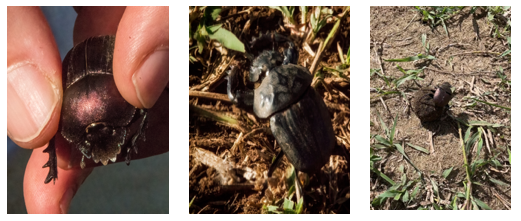MY BIRD RINGING EXPERIENCE AT UKUWELA: FINDING JOY IN LITTLE THINGS
2022 WIldlife Conservation Photographer, Terry Opalka, joined Wild Tomorrow Fund in the field this March for the volunteer trip of a lifetime, using her camera to help conservation. One of the first activities she participated in was bird banding (also called bird ringing) at our Reserve, recording data on 43 individual birds of 17 different species. Read her blog describing this fascinating morning, its importance for conservation and bird research, and the importance of finding joy in the little things.
Terry (middle in purple) and the volunteers are all smiles, recording the bird life at Ukuwela under the guidance of our Reserve Manager and resident bird expert, Kevin Jolliffe. Photo credit: WTF Ambassador Barbara Engel.
— Written and photographed by Terry Opalka.
The 2022 Wild Tomorrow Fund Conservation Photography volunteers had an early morning start at 6:45am to meet for the first time with Kevin Jolliffe, Wild Tomorrow Fund’s Reserve Manager, at the Ukuwela Nature Reserve. It was our first full day on the ground in South Africa with Wild Tomorrow Fund, and our first conservation volunteer activity was to help with bird ringing. Needless to say, we were quite excited to get started as we had all heard so many exciting stories of the process and were looking forward to participating in this amazing opportunity.
You may be wondering, what is bird ringing? And is it safe for the birds?
Bird ringing is one of the oldest and most important techniques used for studying and identifying individual birds. The information gathered allows for the development of effective bird science, management, and conservation. It also allows for keeping track of the movements of the bird and its life history. During the capture, the bird’s measurements are taken and other biometric data are gathered. The subsequent recapture or recovery of the bird can provide information on migration, longevity, mortality, population, territoriality, feeding behavior, and other aspects that are studied by ornithologists.
Caught gently in the mist net: Red-billed Quelea (Quelea quelea)
It’s a special skill to patiently and safely remove each bird from the nets. Blue Waxbill (Uraeginthus angolensis)
The bird ringing process begins with setting up a series of mist nets that stretch out hundreds of feet that are set up the evening before the day of processing. Just before sunrise, the nets are opened to catch any passing birds as the sun rises. The birds fly into the soft mist nets and fall into pouches at the bottom of each section.
Birds wait quietly and calmly in bags, waiting their turn to be recorded and released.
Bird banding (also called bird ringing) tools of the trade.
When we arrived, the Wild Tomorrow staff were already busy gently removing the birds from the nets. They invited us to help and we jumped in very enthusiastically! We learned very quickly that this is not a task for the heavy-handed, it takes patience and awareness to untangle the birds from the nets.
As the birds are removed from the mist nets, they are placed in small cotton sacks where they calmly rest until it is their turn to be processed.
Kevin, who is specially certified, would gently reach into each bag to get the next bird and using a variety of tools, collect their information such as sex and weight while taking measurements of the head, bill, wings, and tail feathers. Lastly, he would put on their rings.
Chinspot Batis (Batis molitor)
Red-Capped Robin-Chat (Cossypha natalensis)
This information gathered is sent to the South African Bird Ringing Unit (SAFRING) based at the University of Cape Town to contribute to research that will benefit the understanding and conservation of bird species.
Bird ringing data sheet.
You may be wondering about the ring that is put on the bird’s leg. It is a ring of suitable size for the individual bird and is usually made of aluminum or other lightweight material. Each ring has a unique number and a contact address. The rings are very light and are designed to have no adverse effect on the birds, they are meant to gain data about the birds allowing them to behave in all respects in the same way as the un-ringed population. This is a very safe procedure for the birds as all ringers in South Africa must be registered with the South African Bird Ringing Unit.
Once the processing is completed, we were given a chance to photograph the birds and then Kevin asked if anyone would like to release the birds. Of course, all our hands shot up into the air! He taught us how to lightly hold the bird’s legs between our fingers and to face away from the processing area so that they would take off into the wide-open spaces of the wild bush. For the most part, the birds would immediately take off and race to the closest tree before moving on, others angled back towards the mist nets and had to be freed again, while other birds sat quietly in our hand for a few short seconds, comfortably resting, before flying away.
“What a thrill that the birds felt safe enough and found comfort to remain in the palm of our hand even if only for a few seconds before taking off. It felt like Mother Nature was giving us a nod for helping and doing conservation work.”
Six of the seventeen bird species recorded during our bird banding session (Top left to right): 1. Blue Waxbill (Uraeginthus angolensis), 2. Green-winged Pytilia (Pytilia melba), 3. Red-Capped Robin-Chat (Cossypha natalensis), 4. Juvenile Red-backed Shrike (Lanius collurio), 5. Golden-breasted Bunting (Emberize flaviventris), 6. Chinspot Batis (Batis molitor)
Being in the wild bush, we had to be careful where we stepped as this is where the wildlife passes through freely when humans like us are not there. Well, at first we were careful, but as the excitement and mystery of the land unfolded around us, we soon forgot about where we were walking, hey we had our hiking boots on so we were ok!
While Kevin worked through to process all of the birds, Greg Canning, Wild Tomorrow Fund’s General Manger, expertly taught us about the Dung Beetles that were all around us and busy at work rolling perfectly round balls of dung back home. Dung beetles are a group of insects that primarily use the dung (poop) of mammals for feeding and nesting. These beetles are important for the breakdown and recycling of dung into the soil, enabling the nutrients in the dung to cycle through the ecosystem. They can roll up nutritious balls of excrement up to 50 times heavier than their own bodies to feed their young. They roll the balls walking backward, with their heads near the ground. It was amusing and interesting watching them rolling along, it looked so effortless. Every now and then they would tumble off the dung ball but they quickly climbed back on and continued to maneuver the challenges of the terrain.
This first close-up exposure to the wildlife (no matter how small) while standing in the wild bush amongst the magnificent landscape of South Africa was exhilarating. While being watched from afar by two inquisitive giraffe, I stood there soaking it all in and marveling at the beauty of where we were, it was both calming and breathtaking at the same time. Watching and learning about the place where animals and creatures of all sizes roam freely, and seeing how they depend on each other and the land to survive, one can’t help than to more fully appreciate the magnitude of how all life on this planet is interconnected.
A curious giraffe at Ukuwela looks at Terry from a safe distance.
Soaking in the beauty of Ukuwela












